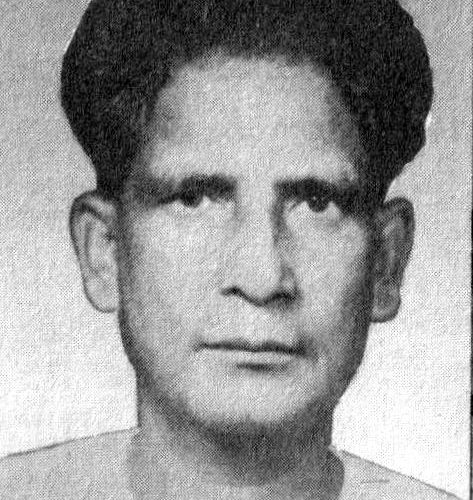October 8 happens to be the 125th birth anniversary of Sri Adivi Bapiraju and this review article comes with a tribute to the great literary genius that he was. Attached is also a popular song written by Sri Bapiraju on the river Godavari. He greatly loved the landscape, the rivers, the history and the culture of Andhras, which includes the physical landscape of both the Telugu speaking states. He had written a beautiful novel that describes the glory of Kakatiyas and their queen Rudrama Devi. On a personal note he was also known to be a close associate of my grandfather Dr. Channapragada Subbarao, who practiced in Bhimavaram, Ramachandrapuram and Rajahmundry, in the delta districts of Godavari.
Adavi Shantisree, Adivi Bapiraju; Jayanti Publications Vijayawada. Reprint 1987. Pages322
Had he been born in any state other than Andhra Pradesh, he would have become as popular as Tagore…perhaps gained greater recognition, for Adivi Bapiraju was an exceptional multi-faceted genius—a painter, a sculptor, a singer, a lyricist, a poet and a novelist, and many other things rolled into one. Any one crossing the river Godavari on the road-cum-rail bridge cannot help but think of his ever famous ‘Uppongi poyindi Godavari, taanu teppunna egisindi Godavari.’
His fame rests on his literary creations mainly poetry and as well as novels. Born in Bhimavaram, in the West Godavari District of Andhra Pradesh on October 8, 1895, he completed his graduation from Arts College, Rajahmundry and later obtained his law degree from Madras. He was the principal of National College, Machilipatnam from 1934 to 1939 and moved on to become the editor of Mizaan magazine in Hyderabad. He was a prolific writer, covering several genres through his poetry, songwriting and novels. When it comes to novels Gona Ganna Reddy, Himabindu, Tuphaanu, Adavi Santhsri, Narayana Rao, Narudu, and Konamgi were some his well-known ones. Narayana Rao was given an award by Andhra Viswakala Parishad tied with Sri Viswanatha Satyanarayana’s Veyi Padagalu. While he was known by the title Kulapati and he was Bapi Bava (a close first cousin or an elder sister’s husband, used here as an endearment term, for most of his contemporaries.
Amongst all the writings of Adavi Bapiraju, his historical novels Adavi Santishree and Gona Gannareddy are very special to the lovers of his writings. Andhra land, history, culture and the rivers of the region occupy a special place in his heart and he goes into high lyrical prose when he describes these in his writings. First mention should be made of the river Krishna in Adavi Santishree which is such sheer poetry that modern readers may turn away from the novel after reading the first chapter. One needs to understand the historical context and back ground of the novel to appreciate it.
The novel was set in the time of Andhra Satavahanas. Satavahana kingdom was founded by Srimukha Satavahana in 230 BC. This story was set in the reign of the last emperor of the dynasty Yagynasri Satakarni. He was a contemporary of the great Buddhist guru Acharya Nagarjuna, then reputed to be 104 years old. He was residing in the Buddhist monastery located on Sriparvata near Vijayapuri, which was ruled by Brahma Dutta of Dhanaka dynasty. He and his father Devadatta were the Amatyas and Mahasenapatis- chief ministers and supreme commanders- of armed forces of the Iksvaku king Shantimula who was a loyal supporter of Yagynasri Satakarni. Shantimula ruled from the city of Dhanyakataka, built by Ikshvakus. Ikshvakus of Dhanyakataka were the direct descendants of Srirama of Ayodhya. Old and now weak Yagnyasri had a rival in his brother’s grandson Pulamavi 2 who had an eye on the Satavahana Kingdom. Yagnasri’s son Vijayasri Satakarni was very weak and was not suited to succeed the great Satavahana kingdom. Apart from many other rivals and contestants to the throne, Pulamavi 2 was the strongest and was constantly trying to overthrow emperor Yagnyasri as he believed that he was the true heir to the kingdom.
When the story opens Brahmadutta was seen worried about the future of Satavahana kingdom amidst the raging conspiracies against the emperor Yagnyasri. Here Adavi Bapiraju the author describes the qualities of head and heart of the commander of King Shantimula’s army Brahmadutta in the traditional style of the nayakas of the Indian aesthetics. He was a Dheerodaatta, Dheeralalitha, Dheerachitta and Dheerashanta. He was courageous, level-headed, firm-hearted and cool-minded, in addition to being a scholar of Hindu scriptures. He wrote a commentary on Bhagawad Gita which was called Brahmadutta Bhashyam. Throughout the novel he was shown as an excellent teacher of Arshya dharma, and at the same time a man who had immense respect for Acharya Nagarjuna. It was seen to be reciprocal too. He along with his king, Shantimula, constantly tried to strike a balance between their faith and their respect for Buddhist faith. They were followed by the queen Sarasika Devi and her daughter Shantishree. Brahmadutta falls in love with princess Shantishree and marries her in the end.
Shantishree was the daughter of King Shantimula of Ikshvaku dynasty. Born to him by his beloved queen Sarasika Devi who was a very devout follower of Acharya Nagarjuna. She sent both her children to Guru Anandarhata to learn the Buddhist scriptures and religion. Another one of Shantimula’s wives was Malavika, the daughter of Satavahana king Yagnyasri Satakarni. She loved her husband for his courage and her co-wife Sarasika as her own sister. Shantishree was a devout Buddhist and was indifferent to many Hindu customs as according to the Buddhist preaching, marriage or any attachment and relationship is thought of as a hindrance to the progress of human beings in their journey towards Moksha. From her childhood days, she was a person of extraordinary of beauty but with practically no emotions or desires. She was unusual even as a child as she never reacted to any advances of affection from any one including her parents. But her genius was never in doubt as she was called by her gurus as someone who can grasp complex aspects after reading it only once, ekasanthagrahi. She was not cold but she was totally innocent of any worldly attachments which puzzled everyone including her own parents
As a worried parent Shantimula decides to engage the services of Brahmadutta to teach the tenets of Hindu religion to his daughter. Brahmadutta was surprised and when he saw her, he was even a little scared. But as he understood her beauty, her genius, he found pleasure in teaching her constantly, guiding her to know the religion of her father and balance it with that of what her mother stood for and believed in. He also understood that she was not cold as many around her thought but her womanhood had not blossomed enough to bring forth normal feelings and emotions that a girl of her age would have had. The different faiths her parents believed in was never any problem too as in those days it was not unusual to find the queens of Andhra kingdom following Buddhism and contributing generously for the establishment of ashrams and Aaramas for Buddhists. Acharya Nagarjuna’s monastery was built on Sri Parvata near Vijayapuri by Pulamavi 1 of Andhra Satavahana dynasty. Acharya Nagarjuna established himself on Sri Parvata and guided the Satavahanas, the Ikhvakus and the Dhanakas of Dhanyakataka, Vijayapuri and Sri Parvata. During the last days of Satavahana kingdom he was instrumental in successfully convincing Iskhvaku Shantimula to become the emperor.
Shantimula had friendly relations with Matharis of Kalinga, Satavahanas of Andhra and Dhanakas of Vijayapuri. All other kingdoms without any effort joined hands in support of Shantimula. A war was fought between Pulamavi 2 and Ikshvaku rulers and was lost by Pulamavi 2. He aspired to marry Shantisree, but Shantisree herself foiled his efforts to kidnap her twice. He finally died while attempting to seduce her to force her into becoming his queen. With his death came the end the story of Adavi Shantisree. She became the wife of Brahmadutta as she herself confessed to him her love and requested to grant her permission to become Bouddha Bhikhyuvu, nun, if he cannot marry her. Brahmadutta who loved her almost from the early days of their association was happy to marry her. The ceremony was performed by Maharshi Devadutta, with the blessings of Acharya Nagarjuna. He predicted one day this union would bring together the two streams of Arshya and Bouddha Dharmas. It was a marriage of not just two individuals, but two cultures, two domineering religious thoughts and two political families. This marriage at the same time was the choice of the couple and not a political alliance as that of Santishree’sbrother Veera Purusha Datta who had to marry twice to strike a political balance in the region in addition to the girl he loved dearly from his youth.
Here one cannot say how much is fiction and how much is history but a reading of history with a nationalist perspective integrating this age old multi-cultural and multi religious Aryavarta as it was known in early Indian history certainly enriches our value system. Hindu dharma never appears as a narrow fanatic faith as it is seen in certain quarters today nor was the Buddhist faith under teachers like Acharya Nagarjuna, who was a reputed descendent of Sage Viswamitra actively, hostile to other schools of thought. There was mutual respect and understanding of the need to live together. Another aspect that needs a definite mention is the mind of Brahmadutta, where he was seen debating within himself whether it was right for him to aspire to marry a girl who is averse to the idea of marriage as her faith teaches her that any desire is detrimental to the progress of human soul towards moksha.
“If Dharma is written for man, if kingdoms are for men, if moksha is for men, how long can men make women a miniscule part of their lives? When can men and women share life on an equal footing? A human world that cannot execute the tenets of the Vedas in the right spirit cannot be expected to do justice to women’s righteous causes, Dharmacharana.” She was unhappy as she had to study a faith that was not hers, with a Guru who was not of her liking. The author Bapiraju surprises us with his logic here and his anxiety that women’s voice should be heard certainly speaks volumes for the progressive thinking for his day and age. His other well-known historical novel Gona ganna Reddy though titled after a Robinhood like highway robber who loots to help the Kakatiya queen Rudrama Devi to establish herself firmly on her throne is another woman-centric historical novel.
*









GOOD WRITE UP ON ADIVI BAPIRAJU
Good tribute to a multi faceted genius.
Thank you Narayana Swamy garu